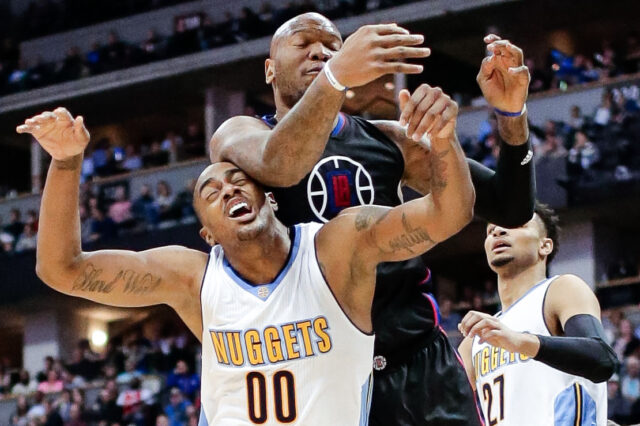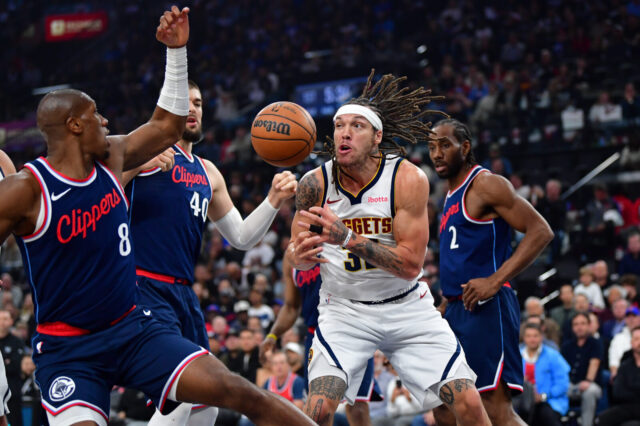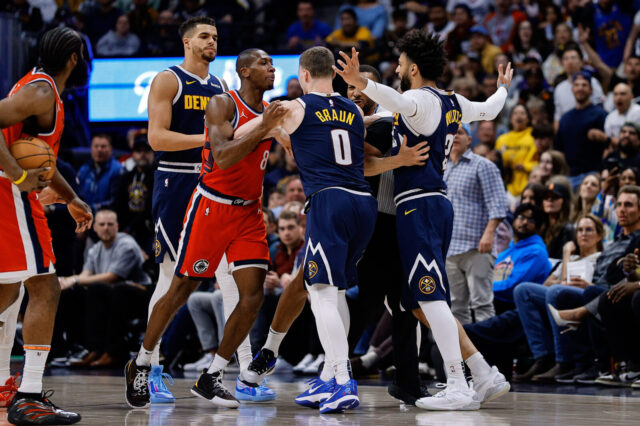It’s becoming clear that in order for the Denver Nuggets to reach true championship contender status, they must improve at the wing position. They have a strong guard group of Jamal Murray, Monte Morris, and Bones Hyland, a strong forward group of Michael Porter Jr., Aaron Gordon, Jeff Green, and Zeke Nnaji, and perhaps the best player in the world at center in Nikola Jokić. At wing though, they need some help. Will Barton will be in the last year of his contract, and after losing PJ Dozier to injury, the Nuggets were down to playing Austin Rivers, Bryn Forbes, and Davon Reed as their primary wings behind Barton. The entire position group needs some revamping.
Fortunately, the 2022 NBA Draft class is full of wing options, and one of the more interesting options is Malaki Branham. At just 19 years old until next May, Branham is certainly young and may not be ready to contribute immediately; however, his scoring and shooting talent is undeniable, and the Nuggets have been all about shooting talent with the majority of their draft picks. Branham is currently projected to be selected higher than 21st overall in the majority of mock drafts, but if he falls to the Nuggets, he feels very much like an upside pick at a position of need.
Let’s discuss:
Vitals
Height: 6’5.5”
Weight: 195 lbs
Wingspan: 6’10”
Age: 19 years old on draft night (05/12/2003)
Malaki Branham’s Freshman Season Per Game Statistics
Branham started slow in his freshman season at Ohio State, scoring no more than 11 points in any of his first 10 games. In his 11th game, he dropped 35 in an overtime win against Nebraska and was unstoppable. After that game, he showed major growth as a scorer and had just three individual games where he shot below 40% from the field. On the season, Branham averaged 13.7 points, 3.6 rebounds, and 2.0 assists in 29.6 minutes per game. He was the second scoring option behind fellow junior and draft prospect E.J. Liddell.
Strengths
Elite shooting season
There’s no doubt about Malaki Branham as a spot up shooter in my mind. He’s everything that teams want with a taller frame, quick, compact release, and the shooting percentages to back it up. He shot 41.6% from three-point range in his freshman season, but almost as important was his 83.3% free throw percentage, a reasonable indicator for his shot translating to the next level.
At Ohio State, Branham made jumpers from all around the perimeter and even dabbled in some pull up three-pointers. That wasn’t really part of his game at the college level, and most of his three-point shots occurred as a standstill three-point shooter. Still, it’s pretty clear that he has elite shooting touch, demonstrating shotmaking success at all levels (more on that in the next section) at a high efficiency.
Only one other freshman guard attempted at least 10 shots per game and shot 49% from the field. Only 27 guard seasons in the Sport Reference database have met those requirements dating back to the 1992-93 season, including James Harden, Ben McLemore, Rodney Stuckey, and Alec Burks among others. It certainly isn’t the end-all be-all of draft analysis, but being efficient from most every spot on the floor as a freshman is a pretty impressive accomplishment.
He’s also a good enough shooter that defenses rotated toward him when coming off of screens and dribble handoffs, which opens up the drop-off pass to a roller. Branham uses his shooting talent to generate a bucket for the team.
“In-between” scoring skills
The best way to describe Malaki Branham’s off-the-dribble game is patient. He avoids being rushed, averaging just 1.7 turnovers per game, and often finds a way to get clean looks from his favorite spots on the floor. At nearly 6’6” in shoes with a 6’10” wingspan, Branham is comfortable shooting over the top of defenders on a variety of jump shots, floaters, and hesitation moves. Branham shot 53% from two-point range this season, an impressive number and higher than the majority of the wing options in the class (Bennedict Mathurin shot 52.1%, Bryce McGowans shot 47.8%, Johnny Davis shot 46.6%, Wendell Moore shot 50.2% for his Duke career).
The distinctive trait in Branham’s in-between game is the advanced footwork and the smooth release. Every single time Branham shoots the ball in the mid-range, it looks like he’s attempted the same shot a thousand times before. It’s consistent and effective with a quick gather and high jump, and it goes in very frequently compared to the majority of college freshmen. He should be able to maintain that at the next level if he stays at shooting guard with his height and physicality for the position.
One more thing: the floater. He’s a solid floater guy and will need to be at his size. It’s an important trait for any scorer looking to avoid contact on occasion, and Branham has it in his bag.
Flashes of athleticism on drives
Because of Branham’s patience and propensity to use his size on drives rather than his speed, it’s difficult to tell just how athletic he is with the ball in his hands. He’s mostly a methodical ball handler, and that will lead to larger players being able to stay in front of him at the next level unless he turns on the jets every once in awhile.
Branham still went back to his right hand off a two-footed jump in the clip above, and that’s the wonder with him: is he always going to be a guy that has to maneuver his way around defenders with his craft and length, or can he start taking off with one foot going forward? There are draft analysts in both camps on that front.
Strong frame
As mentioned before, 6’5.5” with a 6’10” wingspan is definitely good enough at shooting guard, but the kicker is that at 195 pounds, he has the necessary frame to bulk up and handle the rigors of the NBA. Often, young players come into the NBA and have relatively skinny frames. Some can put on weight, but others can’t, and those players are often the ones bullied on switches in the post and on offensive rebounds.
Branham shouldn’t have that problem at the next level. He strikes me as a player that can comfortably get above 210 pounds and remain athletic for the majority of his career. That will be perfectly reasonable for his pro projections.
Weaknesses
Defensive Discipline
The biggest concern with Malaki Branham heading into his NBA tenure is the defensive end of the floor. He wasn’t much of a defender at Ohio State, and he had a lot of possessions where he simply lost connection to his man in relatively simple situations.
Branham isn’t a “stocks” guy, averaging just 1.0 combined steals plus blocks per game. That means his positioning and his discipline have to be good, and they were often lacking.He was often behind the play when put into actions consistently, and that led to easy baskets for the opposition.
Now, Branham is young, and defensive discipline is a difficult area to master as an 18-year-old freshman. His length and frame should help him as the game begins to slow down for him; however, expecting Branham to be a strong defender right off the bat will be next to impossible, and it’s always possible that Branham never becomes a capable defender at all.
I must stress this though: writing off young players as defensive liabilities early in their career when they have a +5 wingspan isn’t really a good idea, and that’s why teams may be willing to overlook some of the defensive questions.
Lateral agility and quickness
Branham’s lateral agility is occasionally called into question on the offensive end, but for me, it’s more of a defensive concern. He struggles to navigate screens and is rarely quick enough or shifty enough to avoid them entirely. It leads to some questions about his ability to be on the floor when the defense needs to get a stop. He might become the target point.
On the offensive end, the top end quickness was mentioned as a question in the strengths category, and it’s one of the reasons why teams have some concerns about his offense translating. As efficient of a pull-up jump shooter as he is, he’s required to go to the pull-up jumper often because he doesn’t get all the way to the rim. His first step is often good, but he often can’t press the advantage before the defense recovers.
Playmaking for others
Branham didn’t often have the ball in his hands for the purpose of playmaking for others, and as a result, he wasn’t much of an assist man in his lone year at Ohio State. 2.0 assists compared to 1.7 turnovers per game isn’t the worst ratio in the world, but it wasn’t a major part of Branham’s game. He’s still young and may develop into a better table setter for others, and in order to reach his maximum potential, he will have to be a better passer.
He does show some flashes, and being taller than others at his position will help him see over the defense to create some nice passing angles. Unfortunately, he’s still definitely learning to read the game, and there’s no telling whether he will be able to run an offense for stretches against high level defenders.
Verdict
The Denver Nuggets are looking to add young talent to their roster, and if Branham’s available with the 21st pick, they’d be hard-pressed to pass on him. Given that Will Barton is now on an expiring contract (and might be traded) and that Denver’s other wing options (Austin Rivers, Bryn Forbes, Davon Reed) are all free agents, it’s safe to say Denver will focus on the wing position this off-season. That could happen in free agency and trades to shore up immediate weaknesses, but the Nuggets would be wise to add a young player at the position in the draft.
Now, many will question whether Branham is the correct wing to add, and it’s fair to question his weaknesses. He isn’t a top flight athlete and struggles to get to the rim and stay connected to his offensive assignment as a result. He also isn’t an elite playmaker, though he does show some signs of being able to recognize and adapt to the way defenses are guarding him.
The most important fact though: Branham projects to be an elite shooter at every level. His shot efficiency in college was very good, and he performed well as an on and off-ball shooter. It’s difficult to teach shooting talent at the NBA level, and the Nuggets have often targeted elite shooters with the hope that they can improve on the defensive end.
If the Nuggets need their first round pick to be a positive contributor immediately, Malaki Branham probably isn’t the right pick for them; however, the Nuggets more than any team have shown a willingness to be patient with draft prospects and are known to draft younger players as a result. If they afford Branham the same flexibility, it’s possible that his ceiling is much, much higher than other wings at his position. Many NBA teams know that, and Branham will likely be snatched up before the Nuggets can select him as a result.
Still, if Branham’s available, he’d be a fantastic pick with possibility to contribute next season and the potential to do much more than that in the future.


